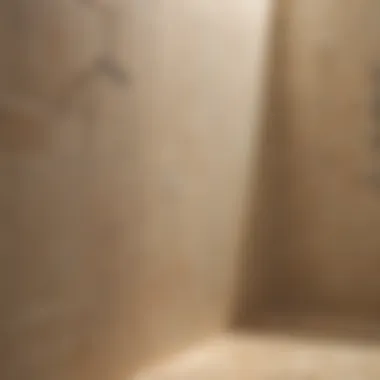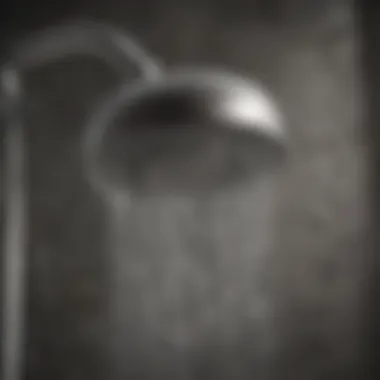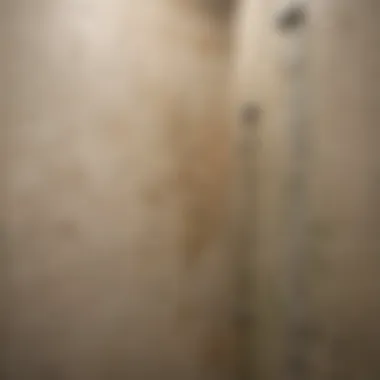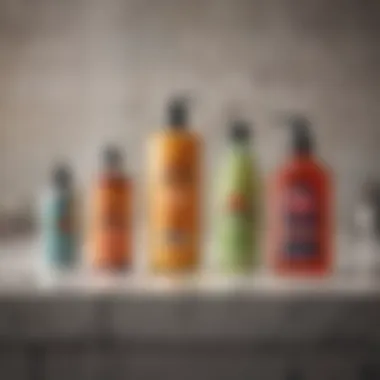Effective Ways to Remove Shower Stains Easily


Intro
Shower stains can be an annoying issue for many people. They often stem from soap scum, hard water, and mildew. The presence of these stains not only hampers the aesthetic appeal of a bathroom but can also lead to hygiene concerns. Understanding the causes of these stains is essential for effective removal.
Many individuals may feel overwhelmed by the potential methods available for cleaning. Some may prefer DIY methods using household items, while others might consider commercial products specifically designed for stain removal. By comprehensively exploring various techniques, this article aims to empower readers with the knowledge to maintain a clean and inviting shower space.
Effective cleaning is not solely about removing existing stains; it also involves taking preventative measures to minimize the future occurrence of them. Insights offered here will help individuals choose the right cleaning agents and application methods, ultimately leading to a hygienic bathroom environment.
Understanding Shower Stains
Understanding shower stains is crucial for maintaining a clean and healthy bathroom environment. Shower stains can arise from various factors, including the use of soap, the quality of water, and humidity levels. Each type of stain has specific characteristics and requires unique approaches for removal. By comprehending these elements, readers can better select appropriate cleaning methods and maintain the hygiene of their showers more effectively.
Types of Shower Stains
Soap Scum
Soap scum forms when soap residue combines with minerals in water. It often appears as a cloudy film on surfaces. One key characteristic of soap scum is that it can build up rapidly if not cleaned regularly. This aspect is important for the article as it shows why proactive cleaning is necessary. Soap scum is often a common issue in homes and thus provides relatable context for readers. Additionally, while soap scum is easy to clean with the right methods, it can be persistent and cause visual disarray in the shower.
Hard Water Deposits
Hard water deposits consist of mineral build-ups, mainly calcium and magnesium, which leave behind white, chalky spots. A notable feature of hard water deposits is their resilience against common cleaning products. This characteristic emphasizes the challenges homeowners face when dealing with hard water stains. Hard water can also lead to other problems like decreased water heater efficiency, thus extending the relevance of this topic.
Mildew and Mold
Mildew and mold flourish in damp environments, making showers a perfect breeding ground. Their unique feature is the ability to spread swiftly, potentially compromising the health of household members. This adds a significant dimension to the article as it highlights not only aesthetic concerns but also health risks. The presence of mold and mildew can lead to serious health issues and indicates poor ventilation and moisture control in the bathroom, underscoring the importance of understanding and removing these stains.
Impact of Shower Stains
Visual Appeal
The visual appeal of a shower can dramatically influence the overall perception of a bathroom. Stains detract from this beauty and can create a sense of neglect. A clean shower elevates the space, making it more inviting. This aspect resonates with many homeowners, as a pristine bathroom can also reflect personal values regarding cleanliness and maintenance. The article aims to encourage readers to consider how these stains can impact their everyday lives.
Hygienic Concerns
Hygienic concerns are paramount when discussing shower stains. The presence of mildew and mold is particularly noteworthy due to their potential to harbor allergens and pathogens. Keeping the shower free from stains not only improves the appearance but also protects health. This discussion underlines the importance of regular cleaning and may motivate readers to adopt better cleaning habits.
Material Degradation
Material degradation is another vital issue associated with shower stains. Certain cleaning products can cause wear and tear on surfaces if not applied correctly. For instance, harsh abrasives might scratch tiles, compromising their integrity over time. This highlights the need for selecting appropriate cleaning methods to preserve the materials used in bathroom installations. Addressing this element enhances the reader's understanding of long-term care and maintenance.
The Science Behind Stains
Understanding the science behind stains is crucial for effectively eliminating them from your shower. This knowledge helps you identify the specific types of stains and their formation mechanisms. Additionally, it informs the selection of the most suitable cleaning methods. By recognizing the underlying scientific principles, you can better tailor your cleaning strategy and expectations, leading to more successful results.
Chemical Composition of Stains
Shower stains primarily consist of soap scum, hard water deposits, mildew and mold. Soap scum forms when soap interacts with minerals in water, resulting in a sticky residue. Hard water deposits, often seen as white chalky marks, are primarily made up of calcium carbonate. Mildew and mold thrive in damp conditions, leading to darker spots that can be difficult to remove. Knowing these compositions allows individuals to choose cleaning agents that target each specific type effectively.
Conditions Promoting Stain Formation
Humidity Levels
Humidity levels play a significant role in the development of shower stains. High humidity creates an ideal environment for mold and mildew to flourish. This is particularly true in bathrooms where moisture accumulates easily. Effective bathroom ventilation can be a crucial factor in controlling humidity. Without proper airflow, humidity tends to compound, leading to persistent stains over time.
Water Quality
Water quality is another essential factor influencing shower stains. Hard water—water with a high mineral content—can leave deposits that are hard to remove. The presence of additional pollutants and substances in the water can exacerbate staining issues. Choosing water softening solutions can significantly improve the cleaning process, as soft water minimizes mineral buildup. However, access to cleaner water quality may not always be feasible in every location which may require alternative interventions for stain management.
Cleaning Frequency
The frequency of cleaning is equally vital for combating shower stains. Regular cleaning ideally prevents the buildup of soap scum, mildew, and water deposits. For those who shower frequently, a cleaning routine every week can be effective. On the other hand, irregular cleaning expands the scope for stain buildup, making it more challenging to maintain a clean atmosphere. Adopting a consistent cleaning schedule not only minimize stains but also helps in maintaining overall hygiene.
DIY Solutions for Removing Shower Stains


Removing shower stains can feel overwhelming to many. However, engaging in do-it-yourself methods not only offers a cost-effective solution but also allows greater control over the materials used. DIY cleaning methods often rely on natural ingredients, which are usually safer for both the environment and human health. Additionally, these approaches tend to be more accessible, as many people already have the necessary items in their homes.
The satisfaction of effectively removing stains using simple and familiar products can promote a sense of accomplishment. Common household items such as vinegar or baking soda can be surprisingly potent in battling soap scum, hard water deposits, and mildew.
Utilizing DIY solutions also allows customization based on personal preferences and specific stain types. While commercial options abound, not all may meet the unique needs of individual showers. Understanding and applying these methods gives homeowners the ability to maintain a clean and inviting bathroom space.
Vinegar and Baking Soda
Vinegar is an excellent choice for tackling shower stains. Combining it with baking soda enhances its cleaning power. This mixture is particularly effective against soap scum and hard water stains. To use this solution, follow these steps:
- Preparation: Gather white vinegar, baking soda, a spray bottle, and a sponge or cloth.
- Mix the Solution: Pour the vinegar into the spray bottle. Then, on the application surface, sprinkle baking soda. The combination will fizz slightly, which is normal.
- Application: Spray the vinegar over the baking soda. The bubbling action helps lift stains.
- Wait: Allow the mixture to sit for at least 15 to 20 minutes. This wait time lets the solution penetrate the stains.
- Scrub and Rinse: After the wait, scrub the area with a sponge, then rinse thoroughly with water.
Vinegar's acidity breaks down mineral deposits, while baking soda acts as a gentle abrasive that helps scrub away grime without damaging surfaces. This method is safe for various materials, including tiles and glass.
Lemon Juice and Salt
Lemon juice is a natural acid that can effectively combat stains while leaving a pleasant scent. Pairing it with salt can increase the efficacy. To utilize lemon juice and salt, do the following:
- Gather Ingredients: You need fresh lemon juice, salt, and a scrub brush or sponge.
- Apply Mixture: Squeeze lemon juice over the stained area. Follow this by sprinkling salt directly onto the stain.
- Scrub: Use the scrub brush to work the lemon juice and salt into the stains. Some light pressure may be necessary to lift stubborn stains.
- Let Sit and Rinse: Allow the mixture to sit for 10 minutes, then rinse with water.
This method not only cleans but also leaves a refreshing scent. However, care should be taken when using it on surfaces like marble, as lemon juice can cause etching over time.
Hydrogen Peroxide
Hydrogen peroxide is often overlooked as a cleaning agent. It is effective in removing mildew and mold stains due to its antifungal properties. Here’s how to use it:
- Set Up: Obtain a bottle of hydrogen peroxide (3% concentration) and a spray bottle.
- Application: Spray hydrogen peroxide onto the affected areas in the shower. Ensure the area is well-covered.
- Wait: Allow it to sit for about 10 minutes, giving it time to work on the stains.
- Rinse: After the waiting period, rinse the area thoroughly with water.
This solution not only targets stains but also helps in killing bacteria and fungi. Always ensure good ventilation when using hydrogen peroxide as it has a strong odor during its application.
Dish Soap Mixtures
Dish soap can be a surprisingly versatile cleaning agent. When mixed with vinegar, it becomes even more effective for shower stains. Follow these instructions:
- Prepare Materials: Use liquid dish soap, vinegar, and a sponge.
- Combine Ingredients: Mix equal parts of dish soap and vinegar in a bowl.
- Apply: Using a sponge, scrub the mixture onto the stained areas of the shower.
- Rinse: Allow it to sit for a few minutes before rinsing with water.
The greasy nature of dish soap helps lift soap scum while vinegar dissolves mineral deposits. This method is efficient for regular cleaning and helps maintain a stain-free shower space.
Commercial Cleaning Products
Shower stains, ranging from soap scum to hard water deposits, can be quite stubborn. While DIY solutions such as vinegar and baking soda can be effective, commercial cleaning products offer more specialized options for tackling these stains. In this section, we will discuss why these products are essential, their variety, safety considerations when using them, and the best application techniques to maximize their effectiveness.
Choosing the Right Product
When it comes to selecting a commercial cleaning product, understanding the types of cleaners available is crucial. Each type serves a specific purpose and can be more effective against certain types of stains.
Types of Cleaners
Common types of cleaners include:
- All-Purpose Cleaners: Suitable for a range of surfaces and stains, these products provide basic cleaning.
- Acid-Based Cleaners: Often contain citric acid or phosphoric acid, making them effective against hard water deposits.
- Soap Scum Removers: Designed specifically to tackle soap scum, these cleaners can restore shine to surfaces.
- Mold and Mildew Cleaners: Contain bleach or antifungal agents ideal for mildew-heavy environments.
Each type has distinct properties and is chosen based on the specific stains one wants to eliminate. For example, acid-based cleaners often work faster on mineral deposits, but they can also damage sensitive surfaces if used improperly. Hence, knowing the stain type helps in selecting the best cleaner.
Safety Considerations
Safety is paramount when working with commercial cleaning products. Understanding their chemical compositions ensures proper handling and application.
Some characteristics including:
- Ventilation Needs: Products may require adequate airflow to avoid inhalation of fumes.
- Skin Contact Rules: Many cleaners can cause skin irritation; gloves are often advisable.
- Storage Information: Proper storage away from children and pets is crucial.
These considerations are beneficial because they prevent health risks while cleaning effectively. For instance, a cleaner that requires professional ventilation cannot be used in small or poorly ventilated spaces.
Application Techniques


Using commercial cleaning products effectively also depends on the correct application technique. Two common methods include shooting the cleaner directly onto the surface or wiping it on with a cloth.
Shooting versus Wiping
- Shooting: This method involves spraying the cleaner directly onto the affected area. It is especially useful for large stains or hard-to-reach corners. The advantages of shooting include:
- Wiping: This technique involves using a cloth or sponge. Wiping is beneficial for more delicate surfaces or general maintenance cleaning. It allows for:
- Quick application, saving time in the cleaning process.
- Ensures that the product can penetrate deeper into the stains.
- Control over how much product is applied, preventing waste.
- A focus on detailed areas, ensuring thorough cleaning.
Leave-On Solutions
Some commercial products come with leave-on formulas. These are designed to be applied and left on the surface to break down stains over time. The key feature is their prolonged exposure on difficult stains for greater effectiveness.
- Benefits of Leave-On Solutions:
- Reduces the need for constant scrubbing, which can be physically exhausting.
- More effective on severe staining, ensuring that tough stains do not return quickly.
While they are advantageous, users should ensure compatibility with their shower materials as prolonged exposure can sometimes cause damage.
"Choosing the right commercial cleaner can be a game changer in maintaining a spotless bathroom."
In summary, commercial cleaning products offer a plethora of options and application techniques for effectively removing shower stains. Selecting the right type and employing the correct application method maximizes results while ensuring safety during use.
Preventative Measures
To combat the persistent issue of shower stains, implementing preventative measures is essential. This aspect is crucial because it not only reduces the frequency of deep cleaning but also helps maintain the overall hygiene and aesthetic of your bathroom. By addressing stains before they become embedded, you can save time and effort in ongoing cleaning chores.
Routine Cleaning Schedule
Establishing a routine cleaning schedule is the cornerstone of stain prevention. Regular upkeep helps in removing soap scum and mildew before they settle in. For optimal results, aim for a quick clean after every shower. This does not have to be labor-intensive; a simple rinse and wipe down of the surfaces can significantly limit buildup.
Furthermore, incorporating a deeper clean once a week will assist in tackling any areas that might have been neglected in your daily routine. Using gentle, suitable cleaning products during these sessions will minimize the risk of damaging your shower’s surfaces.
Water Softening Solutions
Hard water is a common villain in the battle against shower stains. Minerals found in hard water precipitate on surfaces, leading to unsightly deposits. To combat this, consider investing in a water softener, which modifies the water chemistry and reduces mineral content. A softener can significantly decrease the likelihood of hard water stains, providing a more manageable cleaning experience.
Moreover, using showerheads that filter water can also provide a direct benefit. These devices allow you to enjoy cleaner water while reducing the impact of hard water directly on your tiles and glass.
Proper Ventilation
Good ventilation is often an overlooked factor in preventing shower stains. High humidity levels in bathrooms promote mold growth and mildew, which can lead to unattractive stains. Proper ventilation allows for air circulation, which can lower moisture levels post-shower. This can be achieved by using exhaust fans or opening windows to encourage airflow.
Additionally, keeping bathroom doors slightly ajar can allow steam to escape, further reducing the humidity. This simple step can greatly reduce moisture, thus inhibiting the conditions that allow mold and mildew to thrive.
"Prevention is better than cure."
By taking these preventative measures seriously, you not only enhance the cleanliness of your shower but also increase the longevity of the materials within your bathroom. Concentrating on a few strategic habits can yield significant long-term benefits.
Addressing Stubborn Stains
When faced with stubborn stains, it is important to understand their persistence and how they affect both the appearance and hygiene of your shower. Stains may accumulate over time, often resisting standard cleaning efforts. Recognizing the need for targeted interventions can help in restoring the shower's condition.
Addressing stubborn stains not only enhances visual appeal but also promotes a hygienic environment. A cleaner surface discourages mildew growth and other microbial developments, which can pose health risks. Having a plan to tackle stubborn stains improves overall cleaning efficiency. The right techniques can prevent the need for extensive restorations later on.
It is crucial to explore deep cleaning methods and consider enlisting professional help when necessary. Understanding the specific characteristics of different stains can guide the best approach for treatment.
Deep Cleaning Techniques
Scrubbing
Scrubbing is a hands-on approach that involves vigorous physical action to remove stubborn stains. This method effectively dislodges grime from surfaces, making it a fundamental technique in stain removal. One key characteristic of scrubbing is its immediate impact; when performed correctly, it can yield quick results.


The unique feature of scrubbing lies in the mechanical action it provides, allowing for adjustments based on surface material. Scrubbing with an appropriate tool, such as a stiff-bristled brush or sponge, can penetrate textured surfaces effectively. While scrubbing is beneficial for removing tough stains, it does require effort and can be time-consuming. Additionally, improper techniques may lead to scratches or damage on sensitive surfaces.
Steam Cleaning
Steam cleaning uses high-temperature vapor to clean and sanitize surfaces without harsh chemicals. This method aids in breaking down soap scum and mildew, making it an effective choice for stubborn stains. One prevalent aspect of steam cleaning is its ability to reduce the use of chemical products, appealing to those seeking more eco-friendly cleaning solutions.
The unique feature of steam cleaning is its deep penetration into surfaces and the ability to sanitize simultaneously. This method is beneficial as it loosens grime without physical scrubbing, potentially protecting the integrity of your shower materials. However, steam cleaning does come with some disadvantages, such as the need for specialized equipment and potential high costs. Furthermore, some surfaces may not withstand the intense heat, requiring cautious evaluation prior to use.
Consulting Professionals
Seeking professional help may be a viable option for those dealing with chronic or severe staining issues. Professionals often bring specialized tools and extensive experience that can lead to effective results. When consulting professionals, consider the value of their expertise in various cleaning techniques and types of stains.
Professionals can assess the situation more accurately and recommend appropriate treatments, potentially saving time and effort compared to DIY methods. It is essential to weigh the potential benefits of professional cleaning against the costs involved. In some cases, investing in expert cleaning may provide long-term solutions that DIY approaches cannot achieve.
Long-term Maintenance Strategies
Maintaining a clean shower requires consistent effort and strategic actions. Long-term maintenance strategies can significantly reduce the occurrence of stains, ensuring that the shower remains hygienic and visually appealing. These strategies not only address current issues but also prevent future problems that can arise from neglect. Developing a routine is essential. Regular cleaning and minimalizing exposure to water and soap residue can prove beneficial.
One important aspect of long-term maintenance is the selection of effective cleaning tools and materials. Various innovative cleaning tools are available that can help in minimizing stains effectively. Additionally, creating a shower shield can serve as a protective barrier. These shields can reduce the contact between water and the shower surfaces, lessening the likelihood of stains forming over time.
Innovative Cleaning Tools
The market offers a range of innovative cleaning tools designed specifically for shower maintenance. These tools can greatly ease the cleaning process. For example, powered scrubbers can reduce physical strain and enhance efficiency. These devices effectively remove tough stains without requiring excessive scrubbing.
Another useful tool is the microfiber cloth. Its ability to trap dirt and grime makes it excellent for routine wipe-downs. More so, these cloths do not scratch surfaces, which is ideal for delicate materials like glass.
Here are a few noteworthy tools:
- Electric scrubbers: Effortless cleaning with rotating heads.
- Squeegees: Simple tools that help remove water from surfaces post-shower.
- Spray bottles with cleaning solutions: Easy application of cleaners, facilitating regular use.
Incorporating these tools into a cleaning routine can lead to a noticeably cleaner shower over time.
Creating a Shower Shield
Implementing a shower shield is an excellent way to combat stains long-term. A shower shield is designed to prevent water and soap residue from clinging to surfaces. This can significantly minimize the formation of soap scum and hard water deposits.
Various types of products are available in the market, including glass shields and protective sprays. The best shields are typically those designed to enhance water runoff, making it less likely for moisture to linger on surfaces. Proper installation is crucial to ensuring that the shield functions effectively,
When selecting a shower shield, consider products that offer:
- Water-repellent technology: To reduce water pooling.
- Ease of application: Quick setup and maintenance are necessary.
- Durability: Products that withstand constant exposure to moisture are the smartest choice.
Implementing a shower shield can vastly reduce cleaning time and effort in the long run.
Impact of Shower Materials on Stain Resistance
Understanding how different materials impact stain resistance is crucial in maintaining a clean and appealing shower space. Various materials have distinct properties that contribute either positively or negatively to the formation and persistence of stains.
Benefits of Choosing the Right Material
- Ease of Cleaning: Certain materials make it significantly easier to clean. For instance, smooth surfaces prevent grime from adhering strongly.
- Longevity: Stain resistance can influence how long a shower stays in good condition. Materials that are resistant to stains may require fewer repairs or replacements.
- Hygiene: Materials that resist stains can also assist in minimizing bacterial growth, promoting a healthier environment overall.
Glass vs. Plastic Showers
Glass showers are a common choice for many homeowners because they offer a sleek, modern look. They are often resistant to staining when properly treated with suitable cleaners. Special coatings can further enhance this property by creating a non-stick surface for water and soap residue.
On the other hand, plastic showers, while often less expensive, can be more susceptible to stains. Their porous nature makes them more likely to trap soap scum and mildew. It is important to choose high-quality plastic that offers better resistance.
Maintenance Tips
- Regular cleaning is essential for both materials to maintain their appearance.
- For glass, use a squeegee after each shower to reduce water spotting.
- For plastic, a gentle scrub with non-abrasive cleaners can help prevent buildup.
Tile and Grout Considerations
Tiles can provide a beautiful aesthetic, but they come with their own considerations regarding stain resistance. The grout lines between tiles are often the most vulnerable areas. Grout can absorb moisture and stains, leading to a less appealing look.
Using sealed grout can significantly improve its stain resistance. Regular maintenance, including resealing, helps to keep the grout looking fresh and clean. Furthermore, choosing larger tiles can reduce the amount of grout used, which minimizes the potential for staining.
Important Factors to Remember
- Avoid harsh cleaning tools that can damage tile surfaces.
- Utilize specific tile cleaners that are designed to tackle tough stains without harming the finish.







